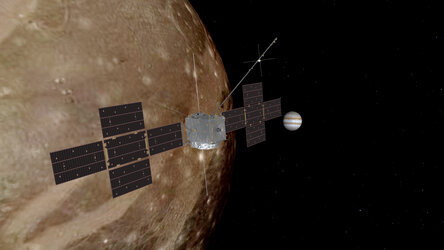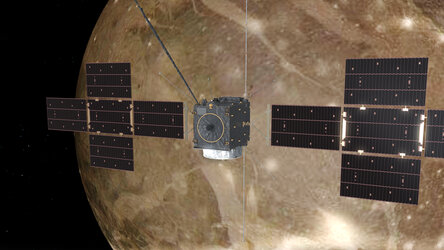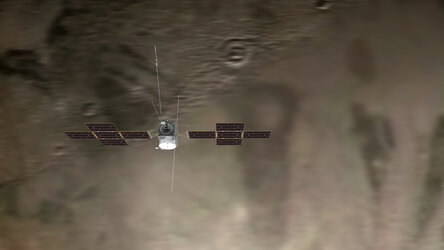Accept all cookies Accept only essential cookies See our Cookie Notice

About ESA
The European Space Agency (ESA) is Europe’s gateway to space. Its mission is to shape the development of Europe’s space capability and ensure that investment in space continues to deliver benefits to the citizens of Europe and the world.
Highlights
ESA - United space in Europe
This is ESA ESA facts Member States & Cooperating States Funding Director General Top management For Member State Delegations European vision European Space Policy ESA & EU Space Councils Responsibility & Sustainability Annual Report Calendar of meetings Corporate newsEstablishments & sites
ESA Headquarters ESA ESTEC ESA ESOC ESA ESRIN ESA EAC ESA ESAC Europe's Spaceport ESA ESEC ESA ECSAT Brussels Office Washington OfficeWorking with ESA
Business with ESA ESA Commercialisation Gateway Law at ESA Careers Cyber resilience at ESA IT at ESA Newsroom Partnerships Merchandising Licence Education Open Space Innovation Platform Integrity and Reporting Administrative Tribunal Health and SafetyMore about ESA
History ESA Historical Archives Exhibitions Publications Art & Culture ESA Merchandise Kids Diversity ESA Brand CentreLatest
Space in Member States
Find out more about space activities in our 23 Member States, and understand how ESA works together with their national agencies, institutions and organisations.
Science & Exploration
Exploring our Solar System and unlocking the secrets of the Universe
Go to topicAstronauts
Missions
Juice Euclid Webb Solar Orbiter BepiColombo Gaia ExoMars Cheops Exoplanet missions More missionsActivities
International Space Station Orion service module Gateway Concordia Caves & Pangaea BenefitsLatest
Space Safety
Protecting life and infrastructure on Earth and in orbit
Go to topicAsteroids
Asteroids and Planetary Defence Asteroid danger explained Flyeye telescope: asteroid detection Hera mission: asteroid deflection Near-Earth Object Coordination CentreSpace junk
About space debris Space debris by the numbers Space Environment Report In space refuelling, refurbishing and removingSafety from space
Clean Space ecodesign Zero Debris Technologies Space for Earth Supporting Sustainable DevelopmentLatest
Applications
Using space to benefit citizens and meet future challenges on Earth
Go to topicObserving the Earth
Observing the Earth Future EO Copernicus Meteorology Space for our climate Satellite missionsCommercialisation
ESA Commercialisation Gateway Open Space Innovation Platform Business Incubation ESA Space SolutionsLatest
Enabling & Support
Making space accessible and developing the technologies for the future
Go to topicBuilding missions
Space Engineering and Technology Test centre Laboratories Concurrent Design Facility Preparing for the future Shaping the Future Discovery and Preparation Advanced Concepts TeamSpace transportation
Space Transportation Ariane Vega Space Rider Future space transportation Boost! Europe's Spaceport Launches from Europe's Spaceport from 2012Latest

Exploring Jupiter and Ganymede (artist’s impression)
This is a GIF from a cinematic animation. Click here to view the animation in full.
Since our ancient ancestors looked up at the skies and saw the brilliant white dot that is Jupiter, we have come a long way in understanding this enormous ball of gas and its menagerie of moons. We have used rudimentary telescopes, high-tech modern telescopes, and space telescopes, the first probes have even passed by for an initial look, but we have never sent a spacecraft to explore the moons close up. ESA’s Jupiter Icy Moons Explorer, Juice, is here to change the game.
Juice will make detailed observations of the giant gas planet and its three large ocean-bearing moons – Ganymede, Callisto and Europa – with a suite of instruments. By making flybys of these moons at distances of just a few hundred kilometres, and even going into orbit around Ganymede, Juice will characterise them as both planetary objects and possible habitats. The mission will also explore Jupiter’s complex environment in depth, and study the wider Jupiter system as an archetype for gas giants across the Universe.
Shown in this video is Jupiter and its giant moon Ganymede – Juice’s primary target, the largest moon in the Solar System, and the only one to generate its own magnetic field.
After arrival in the Jovian system in 2031, Juice will perform five Ganymede flybys to reduce its orbital energy so that it can effectively explore Jupiter; whilst in this ‘Jupiter orbit’ phase of the mission, it will make further flybys to carry out scientific observations, before later transferring from orbit around Jupiter to orbit around Ganymede, becoming the first spacecraft ever to orbit a moon other than our own, and beginning its investigations of the moon in earnest in late 2034. Juice will end its mission by colliding with Ganymede’s surface in 2035.
-
CREDIT
ESA (acknowledgement: ATG Medialab) -
LICENCE
ESA Standard Licence

Exploring Jupiter and Ganymede (artist’s impression)

Juice flyby of Ganymede (artist’s impression)

Juice flyby of Ganymede (artist’s impression)

Juice orbits around Ganymede (artist’s impression)















 Germany
Germany
 Austria
Austria
 Belgium
Belgium
 Denmark
Denmark
 Spain
Spain
 Estonia
Estonia
 Finland
Finland
 France
France
 Greece
Greece
 Hungary
Hungary
 Ireland
Ireland
 Italy
Italy
 Luxembourg
Luxembourg
 Norway
Norway
 The Netherlands
The Netherlands
 Poland
Poland
 Portugal
Portugal
 Czechia
Czechia
 Romania
Romania
 United Kingdom
United Kingdom
 Slovenia
Slovenia
 Sweden
Sweden
 Switzerland
Switzerland

























